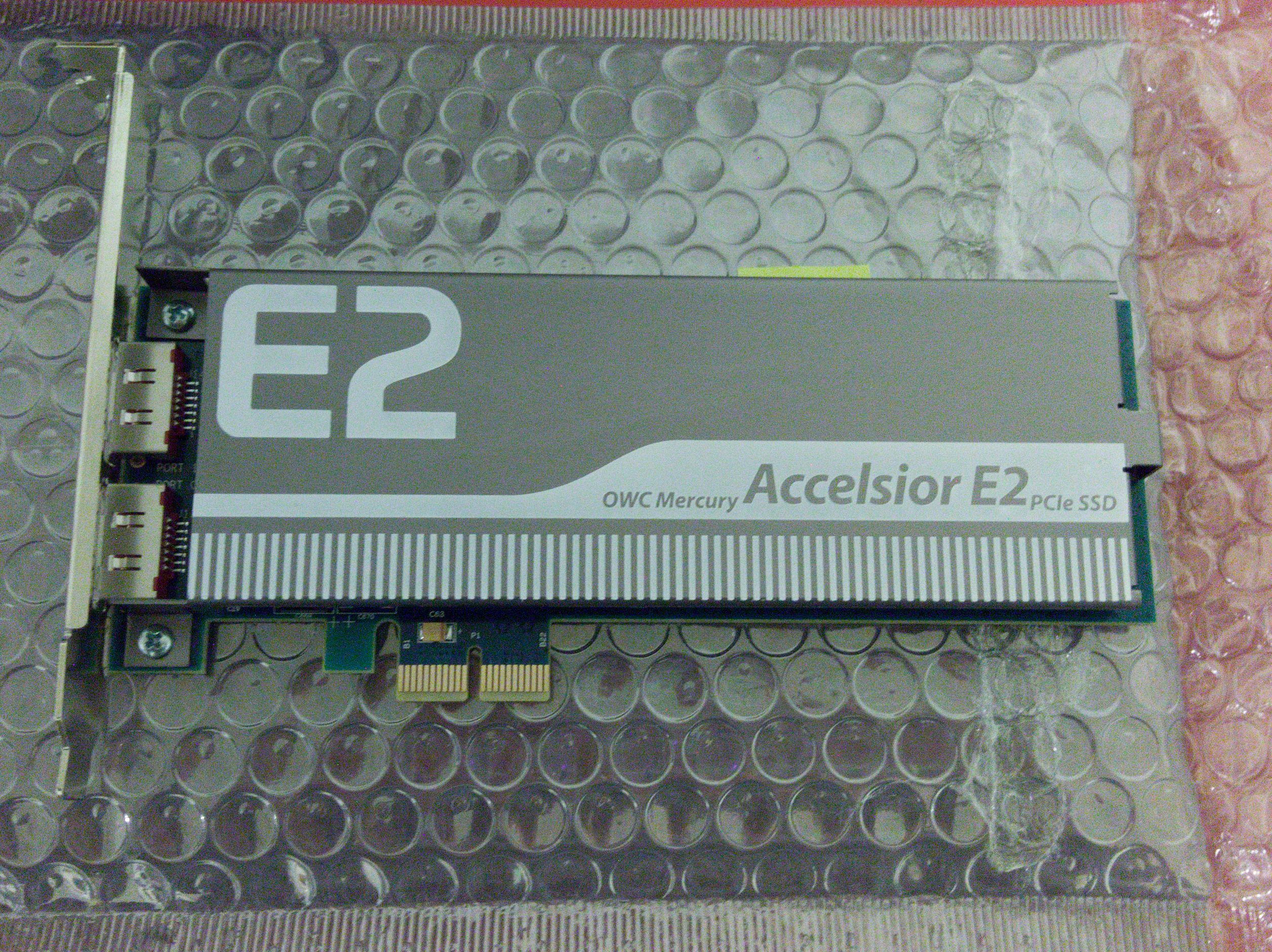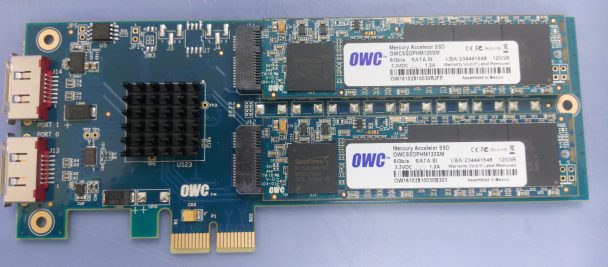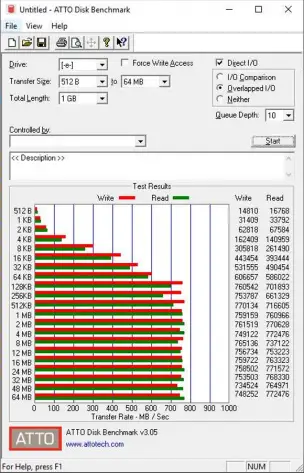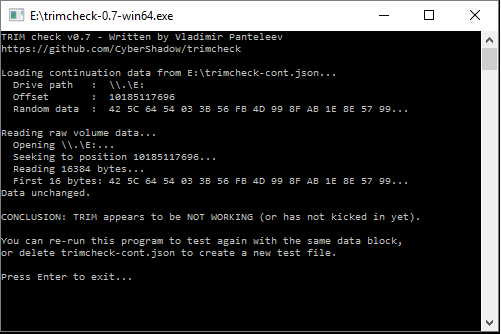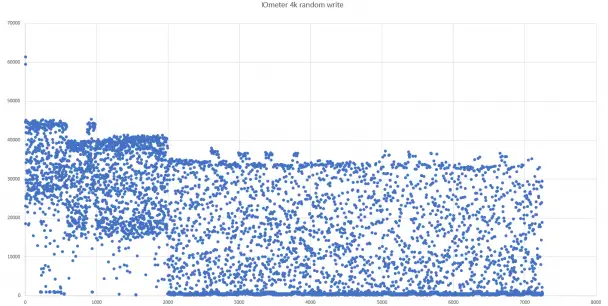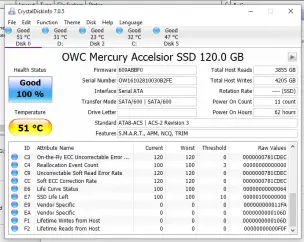OWC Mercury Accelsior E2 Review
Following up on our coverage of the Mushkin Reactor Pocketables has something a little more exotic and perhaps interesting for those of us working with 4k video and other bandwidth demanding tasks. OWC has sent us a sample of the Accelsior E2 PCIE SSD focused on content creators, it is compatible with both pc’s and the last generation 2012 Mac Pro Tower(of which there are many left in use to this day, the video production company I had assist me with testing has 6 of them alone) The sample we were sent is of the 240Gb capacity which is the second lowest, this capacity is built using two 120GB drives in a raid 0.
First Impressions
The Accelsior comes well packaged, the exterior indicating some basic performance information, opening the package we see the card well wrapped in anti-staic bubble wrap as well as an information card about bootcamp(there’s some extra legwork to use it) additionally it includes a low profile bracket(a welcome addition for certain pc’s although not required for the mac pro or our testbench) A bit of an echo from the past is this card using Sandforce 2281 controllers for it’s drive, these were an excellent controller with early 6GB/s ssd’s but have since fallen out of favor due to their age and use of a compression technology to accelerate writes that is rarely required anymore, we’ll explore the effect of this compression our testing where applicable.
| Capacity | 240GB |
|---|---|
| Controller | Dual SF-2281+ Marvell 88SE9230 |
| Firmware | unlisted |
| Interface | PCIe 2.0 x2 |
| NAND | Micron MLC density unlited |
| Sequential Read Ivy Bridge | 823 MB/s |
| Sequential Read Mac Pro | 678 MB/s |
| Sequential Write | 783 MB/s |
| Sequential Write Mac Pro | 688 MB/s |
| 4k Random Read | up to 100,000 IOPS |
| 4k Random Write | up to 100,000 IOPS |
| Temperature range | 0°C to 70°C |
| Dimensions | 20mm X 120mm X 180mm |
| Endurance | Unlisted |
| Warranty | 3 years |
Inside the Accelsior
Before we get into testing I want to take a minute to look inside the cards aluminum shroud, It is easily removed with three screws two of which also secure the retention bracket, we can clearly see the Marvell-88SE9230 under a heatsink. It is a PCIe 2.0×2 SATA controller capable of handling 4 drives two of which are exposed as eSATA ports the other two are in use with the ssd blades. on the blades themselves the Sandforce controller is clearly visible as are the Memory packages although the nand module is obscured completely by the label. OWC merely claims that the drive is built using Tier 1 Major Multi-Level Cell (MLC) High-Performance Sync-NAND Flash in the case of our sample was built using packages from micron. An omission here appears to be any thermal management on the controllers themselves, unlike the Reactor there’s no pads connecting them to the aluminum shroud, I’ve yet to test the impact of adding these but can comment that these do get hot(50c+) in normal operation.
Testing
Unlike before we have a pair of test systems in use, one is a 2012 Mac Pro, the second is the same PC used in the Mushkin reactor testing as a reminder that pc was built using a gigabyte Z77 motherboard equipped with an i5-3470, in the pc the drive was attached to a PCIE 3.0 8x port which eliminates any potential bottleneck with the Accelsior having only a PCIe 2.0×4 connection. The system is running windows 10 Professional and was under no load(AV disabled) for all tests.
macOS
 As the Accelsior is billed as a “Mac Pro hot rodding option” We’ll start with osx, installation was easy simply installing the card in the PCIe slot of our testbench which was a simple affair. After which macOS initially recognized the drive as unreadable but offered to format it where HFS+ was used as the device is intended for permanent installation negating the benefits of ExFAT.
As the Accelsior is billed as a “Mac Pro hot rodding option” We’ll start with osx, installation was easy simply installing the card in the PCIe slot of our testbench which was a simple affair. After which macOS initially recognized the drive as unreadable but offered to format it where HFS+ was used as the device is intended for permanent installation negating the benefits of ExFAT.
Blackmagicdesign’s Disk Speed test
Our primary synthetic benchmark on the mac is Blackmagicdesign’s Disk Speed test which runs a wide variety of access patterns to simulate reading and writing various video formats. Read tests almost all succeeded except the challenging 2160P60 in YUV 4:2:2 write however is more mixed with the more challenging formats struggling due to the Accelsior’s limited 224.5 MB/s write speed. This low write speed is an artifact of the drives low capacity, although the total drive capacity in our test is 240gb this is made up of a pair of smaller 120gb ssd’s which don’t appear to fully populate all 8 channels of the 2281 controller. As professional optimized workloads tend to read from one drive while writing to another this drive would make an excellent data source for a project.
PC
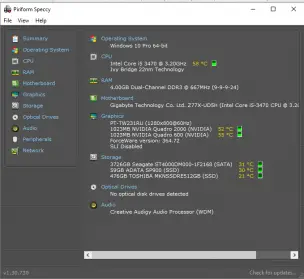
Coming back to the PC we now have the drive installed in our standard testbench, due to the internal nature of the Accelsior we reformat the drive with NTFS using the standard sector size(4kb), windows recognizes the drive properly however crystal disk info is unable to see the ssd’s due to the marvell ROC being preconfigured with a raid 0 fortunately this is something we can change with Marvells storage utilities(and will later on) but for now we will evaluate the drive as it ships.
ATTO
Like before we start off with ATTO Disk Benchmark, ATTO is provided by ATTO technology a designer of fiber channel and other high performance storage devices. We see write performance start to peak at the 128k transfer size with a 760MB/s rate and we see reads starting to peak at the 1Mb size with a similar 760MB/s after this we see both rates fluctuate between 750MB/s and 770MB/s for the remainder of the test. Overall these first numbers here are encouraging although we see some fluctuations they are likely caused by the drive being a pair in raid 0.
Trimcheck
Trim is a requirement for maintaining the performance of any modern SSD and informs a drive which blocks are no longer in use by the file system allowing them to be flushed during garbage collection, as SSD’s have program and erase as separate operations, this helps maintain performance by avoiding degradation as blocks are used, Unfortunately due to the use of the marvell controller to assemble the drives together trim appears non functional. There are ways to restore performance(such as a quick format) without trip however these come at the cost of the data stored on the drive, although that may not be an issue if you’re using this as a “project” drive while editing.
Crystal Disk Mark 5.1.2 x64
Following our preliminary testing with ATTO we have Crystal Disk mark another canned benchmark and a very popular one, we use it in our reviews of lower performance memory products as it’s all inclusive for both sequential and random data. We normally only run our tests using random (incompressible) data as some controllers use compression to accelerate writes and improve performance however in this case we’ve also run it with a highly compressible 0-fill pattern to see just how drastic the effect of compression is. On the sequential side of the equation writes start at 207MB/s for incompressible data and jump to a staggering 759MB/s(far exceeding the limit of standard SATA III drives) Read speeds however are far less affected by the compressibility of the data starting with 567.3MB/s and scaling to 643.2 for such a small drive these are impressive results I imagine the larger 480Gb and 960Gb models would reach better results still. At a queue depth of one we still have similar effects due to compression although they aren’t quite as drastic.
Anvil
Probably the single most comprehensive canned benchmark Anvil’s storage utilities which tests multiple queue depths and access types all with a single button press, write speeds come in at a very low 163.45 sequentially, however that shoots to a more comfortable 504.19 when handling compressible data, read speeds on the other hand are impressive 639.40 with incompressible data and 658.52 with compressible data impressive results and above what a SATA based drive can do we do see 4k random performance scaling with queue depth, an important note here is that the QD4 results which anvil unfortunately only tests for random data turning in 44.33/129.18 (read/write)for incompressible data and little variance with the incompressible data. QD4 indicate s a typical consumer performance ceiling as workloads rarely pass that until you reach enterprise level applications.
AS SSD
AS SSD utilizes incompressible data exclusively in its testing and also reports access times, something missing from most of our other tests and these come back several times slower than the Reactors(.170 and .268 vs .039 and .046 for reads and writes respectively), the reason here is the use of an additional raid controller and pair of drives however even with the added complexity these are still impressive times that a mechanical drive wouldn’t match. The reported performance is impressive as always for reads reaching a staggering 690(higher than anything else has reported) however writes are much lower 137.61 due to the incompressible nature of this test. AS SSD also includes a convenient file copy benchmark showing us what we can expect when moving a variety of data types around on the drive itself, these tests are unfortunately hampered by the low write speeds of the drive.
PCmark8
PCmark 8 includes a variety of real world scenarios using predetermined runs of real world software of which it records the time required to complete them and reports them. Individual times are reported per application in addition these are all used to calculate a total throughput. The Accelsior scores 4835 in this test mostly hampered by it’s low write speed in these tests, bringing it into a comparison with the Reactor we see it’s falling short in the storage bandwidth 2.0 test by the most, a higher capacity Accelsior would tell a very different story here.
Consistency Test
Our custom bombarded with 4k random writes at a queue depth of 32 until it reaches what is referred to as “steady state” at this point we observe how the controller and nand act under their worst case scenario(dirty nand and no time to recover). This test is run for two hours which is more than sufficient to push a drive like the Accelsior e2 into steady state. The results here are a bit mixed, we can see that small inconsistencies get amplified by the raid controller causing erratic performance with drops. Clearly this drive is not intended for use in write heavy DB applications.
Breaking the raid
Under windows it’s possible to break the original array and rebuild it using the windows built in utilities something I’ll cover in depth in the future but want to touch on here for a few reasons. The most important of which is performance although it’s also required in order to properly utilize management tools with the drive. This isn’t something I’d recommend to everyone as there is the potential to cause more harm than good, that said it’s simple enough power users will feel comfortable making changes here.
Management
I traditionally use crystal disk info for basic drive information and monitoring unfortunately it’s not capable of seeing drives that have been assembled in a raid as the controllers present a “virtual drive” which lacks S.M.A.R.T. information. I did this after the bulk of my testing was done to see some information on the drive which was easy enough using marvell’s storage utilities although I wish OWC would provide a first party download for this I understand that the PC is not their primary audience.
Performance
A more surprising side effect in moving to a software based raid solution seems to be a modest change in the drives performance profile, I ran crystal disk mark as a cursory check and noticed a jump in sequential read speeds across the board even exceeding a 100MB/s jump with incompressible data as a queue depth of 32. Although this may vary based on the settings used obviously marvell(the vendor for the raid controller on board) has some work to do if a simple software raid can best their hardware accelerated controller.
Conclusion
At this time we only have a single drive available for comparison which is the Mushkin Reactor we tested at the beginning of the month. These are two very different drives with different applications, the Reactor is a general purpose sata 3 SSD which while well designed is a jack of all trades, the Accelsior E2 is a completely different case with a focus on video editing as well as being aimed towards users of the mac pro 2012(which lacks sata 3) . So who is the drive for? If your platform lacks NVME capabilities(the 2012 mac pro and anything older than Z97 and even then rarely as an m.2 slot) and you’re unwilling or unable to upgrade it the Accelsior is an interesting proposition available 240, 480 and 960 capacities it’s not the cheapest drive with it’s price ranging from 279.75-578.50 on amazon(in line with the proces directly from OWC but with prime shipping) but it does also add 2 eSATA ports a nice value add. For people working with large volumes of photos or 4k video even at the smallest size this drive offers an excellent alternative to rebuilding a system.

